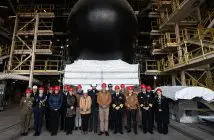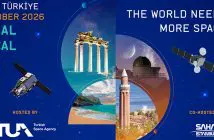
Over 120 years after one of the most significant breakthroughs in communication – the first transatlantic radio signal – scientists are once again seeking to send invisible messages across the Atlantic. But this time, no one can listen in.
Researchers in Europe and Canada are developing technology that will allow them to fire quantum-coded messages across continents via satellites in space, laying the foundation for a new kind of internet – one that is fundamentally unhackable.
Called HYPERSPACE, the international project is pushing beyond the limits of fibre-based quantum links and making space the next frontier in ultra-secure communication. By sending quantum-secured light between satellites and ground stations, the team is working to lay the foundations for a future quantum internet that could span continents and keep data private by design.
While a fully operational transatlantic quantum link remains years away, HYPERSPACE aims to tackle the core scientific and technological challenges that would make such a breakthrough possible.
The project is widely seen as a modern echo of Marconi’s pioneering transatlantic radio transmission in 1901. Just as that breakthrough ushered in the age of wireless communication, HYPERSPACE could mark the beginning of a quantum-powered internet built not on cables and code but on entangled particles and the laws of physics.
Marconi successfully received the first transatlantic radio signal on 12 December 1901. The signal – the Morse code for the letter “S” – was sent from Poldhu in Cornwall, England, and received by Marconi at Signal Hill in St. John’s, Newfoundland, Canada.
“HYPERSPACE is working on a way to generate totally secure encryption keys at a distance through space using quantum technology,” said project coordinator Professor Dr. Fabian Steinlechner. “One day, this could connect entire continents with communication that’s impossible to hack. Today, Europe and Canada are building the foundation for that future by testing how we can transmit quantum signals between satellites and the ground.”
Previous breakthroughs – like China’s Micius satellite transmitting quantum signals between Asia and Europe – have shown what’s possible, but the Atlantic remains unconquered. HYPERSPACE aims to change that by developing the technology and protocols necessary to establish a secure, cross-continental quantum connection, thereby opening the door to a truly global quantum internet.
Backed by the European Union together with the Government of Canada and supported by the Quantum Flagship, the project brings together world-leading scientists to make it happen in the future.
What is Entanglement?
At the heart of HYPERSPACE is a strange phenomenon called entanglement, described by Einstein as “spooky action at a distance.”
In a simple analogy, entangled particles behave like identical twins. The entangled twins can have one of two eye colours, blue or brown. When we determine the eye colour of one of the twins, then we know instantaneously what the eye colour of its twin is. The weird thing is that, according to quantum theory, the eye colour is not determined until we actually measure (or ‘look at’) it. The results are completely random, but randomly, just the same, even if they’re thousands of miles apart. This means you can use them to securely generate random encryption keys (the secret codes behind locked communications) in a way that’s impossible to copy or spy on, not even with the supercomputers of the future.
Quantum communication is not secured by complex passwords or encryption algorithms but protected by the strange physics of entangled particles. These quantum signals can be sent through fibre-optic cables or even beamed through open space, but unlike conventional data, any attempt to intercept them immediately breaks the connection and exposes the eavesdropper.
Right now, most quantum communication systems rely on photons travelling through fibre-optic cables to share encryption keys. But fibre-based systems on the ground can only go so far: after a few hundred kilometres, the signal weakens and becomes unreliable. This is why the HYPERSPACE team is looking to space: to explore how quantum signals can be sent between satellites and ground stations, enabling secure communication over vast distances.
High-Dimensional Entanglement
The team is exploring how to encode multiple quantum bits (qubits) onto a single photon to create ‘high-dimensional entanglement’, essentially packing more information at once.
Quantum entanglement is powerful, but usually, it only enables one bit of information at a time to be sent, like one car driving down a single-track road. With high-dimensional entanglement, it’s like adding extra lanes to the road. Suddenly, multiple vehicles can move side by side, which means more information travels faster, with less chance of slowdowns or interference.
Professor Dr Fabian Steinlechner said: “High-dimensional entanglement also makes the whole system tougher: if there’s interference (like noise or hacking attempts), the signal keeps going strong because it’s spread across more channels. In short, it means faster speeds, greater security, and more information packed into every pulse of quantum light.”
Proof of Concept
Although the idea of a space-based quantum internet is still in its infancy, HYPERSPACE is currently focused on building the proof of concept on shorter terrestrial free-space optical links. The project’s goal is to develop and test the core technologies needed to make secure quantum communication between Europe and Canada possible – from advanced photon sources to protocols for high-dimensional entanglement. If successful, it would pave the way for a fully operational quantum link in the future, offering a blueprint for intercontinental quantum networks.
The longer-term goal is a quantum internet: a global system for secure data sharing, precise navigation, advanced sensing, and cloud computing – all protected from hackers by the fundamental laws of physics. Unlike traditional encryption, which powerful computers can eventually crack, quantum communication makes eavesdropping impossible: any attempt to intercept the signal would instantly leave a trace.
Why is Europe taking the lead?
While global interest in quantum networks is growing rapidly, Europe has established a strong lead in quantum optics and photonic integration, both of which are crucial for scaling quantum communications from laboratory experiments to spaceborne networks.
Under the Horizon Europe programme, the EU is co-funding HYPERSPACE alongside Canada’s Natural Sciences and Engineering Research Council (NSERC).
The initiative brings together scientists from leading research institutes across Germany, France, Italy, Austria, and Canada. Together, they’re building the full tech chain: quantum light sources, signal encoders, detectors, and space-compatible optical systems, culminating in proof-of-concept demonstrations of high-dimensional quantum entanglement transmission through real atmospheric links.
The HYPERSPACE consortium, which will conclude in September this year, consists of eight leading research institutions from Europe and Canada, including Fraunhofer IOF in Germany, CEA-Leti in France, TU Wien in Austria, the Universities of Padua and Pavia in Italy, and, from Canada, the Institut National de la Recherche Scientifique, the University of Toronto, and the University of Waterloo.





